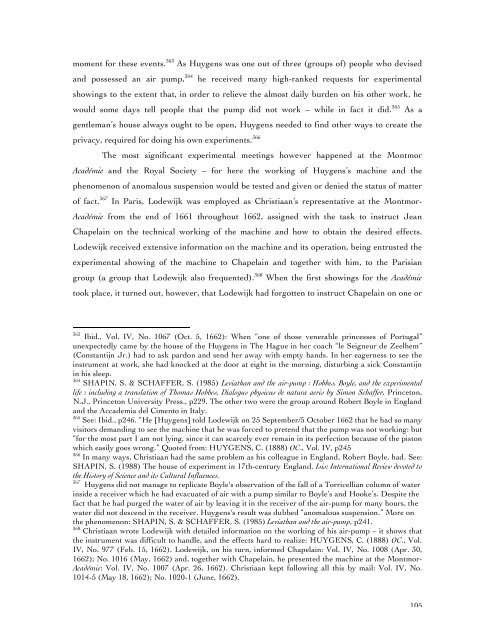Christiaan Huygens – A family affair - Proeven van Vroeger
Christiaan Huygens – A family affair - Proeven van Vroeger
Christiaan Huygens – A family affair - Proeven van Vroeger
You also want an ePaper? Increase the reach of your titles
YUMPU automatically turns print PDFs into web optimized ePapers that Google loves.
moment for these events. 363 As <strong>Huygens</strong> was one out of three (groups of) people who devised<br />
and possessed an air pump, 364 he received many high-ranked requests for experimental<br />
showings to the extent that, in order to relieve the almost daily burden on his other work, he<br />
would some days tell people that the pump did not work <strong>–</strong> while in fact it did. 365 As a<br />
gentleman’s house always ought to be open, <strong>Huygens</strong> needed to find other ways to create the<br />
privacy, required for doing his own experiments. 366<br />
The most significant experimental meetings however happened at the Montmor<br />
Académie and the Royal Society <strong>–</strong> for here the working of <strong>Huygens</strong>’s machine and the<br />
phenomenon of anomalous suspension would be tested and given or denied the status of matter<br />
of fact. 367 In Paris, Lodewijk was employed as <strong>Christiaan</strong>’s representative at the Montmor-<br />
Académie from the end of 1661 throughout 1662, assigned with the task to instruct Jean<br />
Chapelain on the technical working of the machine and how to obtain the desired effects.<br />
Lodewijk received extensive information on the machine and its operation, being entrusted the<br />
experimental showing of the machine to Chapelain and together with him, to the Parisian<br />
group (a group that Lodewijk also frequented). 368 When the first showings for the Académie<br />
took place, it turned out, however, that Lodewijk had forgotten to instruct Chapelain on one or<br />
363 Ibid., Vol. IV, No. 1067 (Oct. 5, 1662): When “one of those venerable princesses of Portugal”<br />
unexpectedly came by the house of the <strong>Huygens</strong> in The Hague in her coach “le Seigneur de Zeelhem”<br />
(Constantijn Jr.) had to ask pardon and send her away with empty hands. In her eagerness to see the<br />
instrument at work, she had knocked at the door at eight in the morning, disturbing a sick Constantijn<br />
in his sleep.<br />
364 SHAPIN, S. & SCHAFFER, S. (1985) Leviathan and the air-pump : Hobbes, Boyle, and the experimental<br />
life : including a translation of Thomas Hobbes, Dialogus physicus de natura aeris by Simon Schaffer, Princeton,<br />
N.J., Princeton University Press., p229. The other two were the group around Robert Boyle in England<br />
and the Accademia del Cimento in Italy.<br />
365 See: Ibid., p246. “He [<strong>Huygens</strong>] told Lodewijk on 25 September/5 October 1662 that he had so many<br />
visitors demanding to see the machine that he was forced to pretend that the pump was not working: but<br />
“for the most part I am not lying, since it can scarcely ever remain in its perfection because of the piston<br />
which easily goes wrong.” Quoted from: HUYGENS, C. (1888) OC., Vol. IV, p245<br />
366 In many ways, <strong>Christiaan</strong> had the same problem as his colleague in England, Robert Boyle, had. See:<br />
SHAPIN, S. (1988) The house of experiment in 17th-century England. Isis: International Review devoted to<br />
the History of Science and its Cultural Influences.<br />
367 <strong>Huygens</strong> did not manage to replicate Boyle's observation of the fall of a Torricellian column of water<br />
inside a receiver which he had evacuated of air with a pump similar to Boyle’s and Hooke’s. Despite the<br />
fact that he had purged the water of air by leaving it in the receiver of the air-pump for many hours, the<br />
water did not descend in the receiver. <strong>Huygens</strong>'s result was dubbed “anomalous suspension.” More on<br />
the phenomenon: SHAPIN, S. & SCHAFFER, S. (1985) Leviathan and the air-pump, p241.<br />
368 <strong>Christiaan</strong> wrote Lodewijk with detailed information on the working of his air-pump <strong>–</strong> it shows that<br />
the instrument was difficult to handle, and the effects hard to realize: HUYGENS, C. (1888) OC., Vol.<br />
IV, No. 977 (Feb. 15, 1662). Lodewijk, on his turn, informed Chapelain: Vol. IV, No. 1008 (Apr. 30,<br />
1662); No. 1016 (May, 1662) and, together with Chapelain, he presented the machine at the Montmor-<br />
Académie: Vol. IV, No. 1007 (Apr. 26, 1662). <strong>Christiaan</strong> kept following all this by mail: Vol. IV, No.<br />
1014-5 (May 18, 1662); No. 1020-1 (June, 1662).<br />
105


